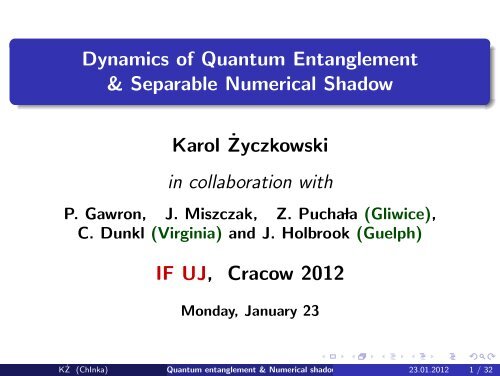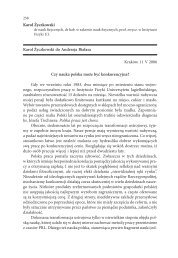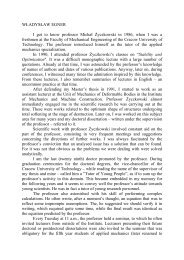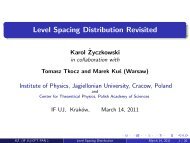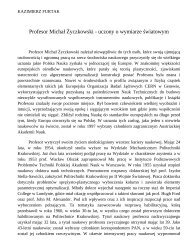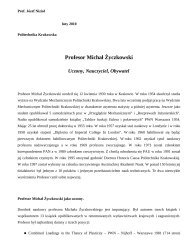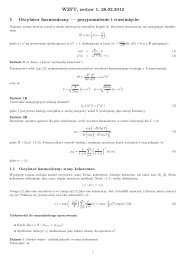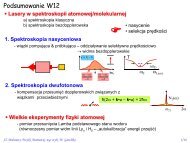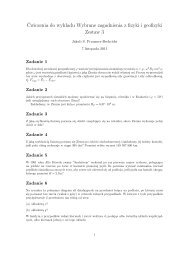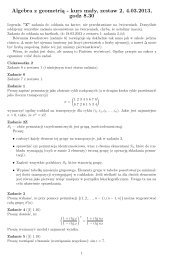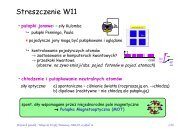Dynamics of Quantum Entanglement & Separable Numerical ...
Dynamics of Quantum Entanglement & Separable Numerical ...
Dynamics of Quantum Entanglement & Separable Numerical ...
You also want an ePaper? Increase the reach of your titles
YUMPU automatically turns print PDFs into web optimized ePapers that Google loves.
<strong>Dynamics</strong> <strong>of</strong> <strong>Quantum</strong> <strong>Entanglement</strong><br />
& <strong>Separable</strong> <strong>Numerical</strong> Shadow<br />
Karol ˙Zyczkowski<br />
in collaboration with<br />
P. Gawron, J. Miszczak, Z. Pucha̷la (Gliwice),<br />
C. Dunkl (Virginia) and J. Holbrook (Guelph)<br />
IF UJ, Cracow 2012<br />
Monday, January 23<br />
K ˙Z (ChInka) <strong>Quantum</strong> entanglement & <strong>Numerical</strong> shadow 23.01.2012 1 / 32
Composed systems & entangled states<br />
bi-partite systems: H = HA ⊗ HB<br />
separable pure states: |ψ〉 = |φA〉 ⊗ |φB〉<br />
entangled pure states: all states not <strong>of</strong> the above product form.<br />
Two–qubit system: N = 2 × 2 = 4<br />
Maximally entangled Bell state |ϕ + 〉 := 1<br />
<br />
√ |00〉 + |11〉<br />
2<br />
<strong>Entanglement</strong> measures<br />
For any pure state |ψ〉 ∈ HA ⊗ HB define its partial trace σ = TrB|ψ〉〈ψ|.<br />
Definition: <strong>Entanglement</strong> entropy <strong>of</strong> |ψ〉 is equal to von Neuman entropy<br />
<strong>of</strong> the partial trace<br />
E(|ψ〉) := −Tr σ ln σ<br />
The more mixed partial trace, the more entangled initial pure state...<br />
K ˙Z (ChInka) <strong>Quantum</strong> entanglement & <strong>Numerical</strong> shadow 23.01.2012 2 / 32
<strong>Entanglement</strong> <strong>of</strong> mixed quantm states<br />
Mixed states<br />
separable mixed states: ρsep = <br />
j pjρ A j ⊗ ρB j (∗∗)<br />
entangled mixed states: all states not <strong>of</strong> the above product form.<br />
How to find, whether a given density matrix ρ<br />
can be written in the form (**) and is separable ?<br />
The separability problem is solved only for the simplest cases<br />
for 2 × 2 and 2 × 3 problems...<br />
<strong>Entanglement</strong> <strong>of</strong> formation for a mixed state ρ<br />
<br />
E(ρ) := min qiE(|ψj〉<br />
E<br />
where the minimum is taken over all ensembles<br />
E = {qj, |ψj〉} : <br />
j qj|ψj〉〈ψj| = ρ.<br />
j<br />
K ˙Z (ChInka) <strong>Quantum</strong> entanglement & <strong>Numerical</strong> shadow 23.01.2012 3 / 32
Two–qubit mixed states<br />
The maximal ball inscribed into M (4) <strong>of</strong> radius r4 = 1/ √ 12 centred at<br />
ρ∗ = /4 is separable !<br />
thetrahedron <strong>of</strong> eigenvalues<br />
K. ˙Z, P.Horodecki, M.Lewenstein, A.Sanpera, 1998<br />
K ˙Z (ChInka) <strong>Quantum</strong> entanglement & <strong>Numerical</strong> shadow 23.01.2012 4 / 32
Two–qubit mixed states<br />
Degree <strong>of</strong> entanglement: a distance to the closest separable state<br />
K. ˙ Z, M. Ku´s, 2001<br />
(entanglement <strong>of</strong> formation)<br />
K ˙Z (ChInka) <strong>Quantum</strong> entanglement & <strong>Numerical</strong> shadow 23.01.2012 5 / 32
Discrete Time Evolution & <strong>Quantum</strong> Maps<br />
<strong>Quantum</strong> operation: linear, completely positive trace preserving map<br />
Enviromental form<br />
ρ ′ = Φ(ρ) = TrE [U (ρ ⊗ ωE ) U † ] .<br />
where ωE is an initial state <strong>of</strong> the environment while UU † = .<br />
Kraus form<br />
ρ ′ = Φ(ρ) = <br />
i AiρA †<br />
i ,<br />
where the Kraus operators satisfy <br />
i A†<br />
i Ai = .<br />
K ˙Z (ChInka) <strong>Quantum</strong> entanglement & <strong>Numerical</strong> shadow 23.01.2012 6 / 32
A model discrete quantum dynamics<br />
a) unitary dynamics (rotation), ρ ′ = UρU †<br />
b) decoherence (contraction), ρ ′′ = k<br />
i Aiρ ′ A †<br />
i<br />
Two qubit model : N = 2 × 2 = 4<br />
a) free evolution: U = exp(itH) where H = σx ⊗ σy<br />
(non-local unitary dynamics !)<br />
variant b1) bistochastic channel: Φ(/N) = /N,<br />
One–qubit Pauli channel: k = 4, A1 = √ 1 − ɛ ⊗ ,<br />
A2 = ɛ/3 ⊗ σx, A3 = ɛ/3 ⊗ σy , A4 = ɛ/3 ⊗ σz.<br />
variant b2) non bistochastic channel:<br />
One qubit amplitude damping channel, (decaying channel), k = 2,<br />
where A1 = ⊗ B1 and A2 = ⊗ B2<br />
with B1 =<br />
1 0<br />
0 √ p<br />
<br />
and B2 =<br />
0 √ 1 − p<br />
0 0<br />
K ˙Z (ChInka) <strong>Quantum</strong> entanglement & <strong>Numerical</strong> shadow 23.01.2012 7 / 32
<strong>Dynamics</strong> <strong>of</strong> entanglement<br />
<strong>Entanglement</strong> <strong>of</strong> formation E as a function <strong>of</strong> time tn<br />
for some initially pure states <strong>of</strong> a two–qubit system.<br />
revivals <strong>of</strong> entanglement<br />
K ˙Z (ChInka) <strong>Quantum</strong> entanglement & <strong>Numerical</strong> shadow 23.01.2012 8 / 32
<strong>Dynamics</strong> <strong>of</strong> entanglement<br />
<strong>Entanglement</strong> <strong>of</strong> formation E as a function <strong>of</strong> time tn<br />
for some initially pure states <strong>of</strong> a two–qubit system.<br />
sudden death <strong>of</strong> entanglement<br />
K. ˙Z, P.Horodecki, M.Horodecki, R.Horodecki, PRA 2001<br />
the name coined by Yau and Eberly,<br />
who independently reported this effect in 2003.<br />
K ˙Z (ChInka) <strong>Quantum</strong> entanglement & <strong>Numerical</strong> shadow 23.01.2012 9 / 32
<strong>Dynamics</strong> <strong>of</strong> entanglement<br />
A general, geometric picture<br />
The effects <strong>of</strong><br />
a) unitary evolution (rotation <strong>of</strong> the body <strong>of</strong> mixed states) induces<br />
oscillations <strong>of</strong> entanglement (revivals!)<br />
b) non–unitary evolution (decoherence): an increase <strong>of</strong> the degree <strong>of</strong><br />
mixing (von Neumann entropy) sends the trajectory into the separable<br />
central region <strong>of</strong> the set <strong>of</strong> mixed states.<br />
K ˙Z (ChInka) <strong>Quantum</strong> entanglement & <strong>Numerical</strong> shadow 23.01.2012 10 / 32
Operator theory: <strong>Numerical</strong> Range (Field <strong>of</strong> Values)<br />
Definition<br />
For any operator A acting on HN one defines its NUMERICAL RANGE<br />
(Wertevorrat) as a subset <strong>of</strong> the complex plane defined by:<br />
Hermitian case<br />
Λ(A) = {〈x|A|x〉 : |x〉 ∈ H N , 〈x|x〉 = 1}. (1)<br />
For any hermitian operator A = A † with spectrum λ1 ≤ λ2 ≤ · · · ≤ λN its<br />
numerical range forms an interval: the set <strong>of</strong> all possible expectation<br />
values <strong>of</strong> the observable A among arbitrary pure states, Λ(A) = [λ1, λN].<br />
K ˙Z (ChInka) <strong>Quantum</strong> entanglement & <strong>Numerical</strong> shadow 23.01.2012 11 / 32
<strong>Numerical</strong> range and its properties<br />
Compactness<br />
Λ(A) is a compact subset <strong>of</strong> C.<br />
Convexity: Hausdorf-Toeplitz theorem<br />
- Λ(A) is a convex subset <strong>of</strong> C.<br />
Example<br />
<strong>Numerical</strong> range for random matrices <strong>of</strong> order N = 6<br />
a) normal, b) generic (non-normal)<br />
<br />
<br />
<br />
0.4<br />
0.2<br />
<br />
0.5 0.5 1.0 Re<br />
0.2<br />
0.4<br />
0.6<br />
Im<br />
<br />
<br />
<br />
<br />
<br />
2 1 1 2<br />
<br />
K ˙Z (ChInka) <strong>Quantum</strong> entanglement & <strong>Numerical</strong> shadow 23.01.2012 12 / 32<br />
2<br />
1<br />
1<br />
2<br />
Im<br />
<br />
<br />
Re
<strong>Numerical</strong> range & quantum states:<br />
Set <strong>of</strong> pure states <strong>of</strong> a finite size N:<br />
Let ΩN = P N−1 denotes the set <strong>of</strong> all pure states in HN.<br />
Example: for N = 2 one obtains Bloch sphere, Ω2 = P 1 .<br />
Probability distributions on complex plane supported in Λ(A)<br />
- Fix an arbitrary operator A <strong>of</strong> size N,<br />
- Generate random pure states |ψ〉 <strong>of</strong> size N<br />
(with respect to unitary invariant, Fubini–Study measure) and analyze<br />
their contribution 〈ψ|A|ψ〉 to the numerical range on the complex plane....<br />
Probability distribution: (a ’numerical shadow’)<br />
PA(z) :=<br />
<br />
ΩN<br />
is supported on Λ(A). How it looks like?<br />
dψ δ z − 〈ψ|A|ψ〉 <br />
K ˙Z (ChInka) <strong>Quantum</strong> entanglement & <strong>Numerical</strong> shadow 23.01.2012 13 / 32
Normal case: a ’shadow’ <strong>of</strong> the classical simplex...<br />
Normal matrices <strong>of</strong> size N = 2 with spectrum {λ1, λ2}<br />
Distribution PA(z) covers uniformly the interval [λ1, λ2] on the complex<br />
plane,<br />
Examples for diagonal matrices A <strong>of</strong> size two and three<br />
1.0<br />
0.5<br />
0.0<br />
−0.5<br />
Density plot <strong>of</strong> numerical range <strong>of</strong> operator [1, 0; 0, i]<br />
−1.0<br />
−1.0 −0.5 0.0 0.5 1.0<br />
1.0<br />
0.5<br />
0.0<br />
−0.5<br />
Density plot <strong>of</strong> numerical range <strong>of</strong> operator diag(1, i, −i)<br />
−1.0<br />
−1.0 −0.5 0.0 0.5 1.0<br />
Normal matrices <strong>of</strong> order N = 3 with spectrum {λ1, λ2, λ3}<br />
Distribution PA(z) covers uniformly the triangle ∆(λ1, λ2, λ3) on the<br />
K ˙Z (ChInka) <strong>Quantum</strong> entanglement & <strong>Numerical</strong> shadow 23.01.2012 14 / 32
Normal case: a ’shadow’ <strong>of</strong> the classical simplex...<br />
Normal matrices <strong>of</strong> size N = 4 with spectrum {λ1, λ2, λ3, λ4}<br />
Distribution PA(z) covers the quadrangle (λ1, λ2, λ3, λ4) with the density<br />
determined by projection <strong>of</strong> the regular tetrahedron (3–simplex) on the<br />
complex plane<br />
1.0<br />
0.5<br />
0.0<br />
−0.5<br />
Density plot <strong>of</strong> numerical range <strong>of</strong> operator diag(1, exp(iπ/3), exp(i2π/3), −1)<br />
−1.0<br />
−1.0 −0.5 0.0 0.5 1.0<br />
Examples for diagonal matrices A <strong>of</strong> size four. Observe shadow <strong>of</strong> the<br />
edges <strong>of</strong> the tetrahedron = the set <strong>of</strong> all classical mixed states for<br />
N = 4. K ˙Z (ChInka) <strong>Quantum</strong> entanglement & <strong>Numerical</strong> shadow 23.01.2012 15 / 32
<strong>Numerical</strong> range for matrices <strong>of</strong> order N = 2.<br />
with spectrum {λ1, λ2}<br />
a) normal matrix A ⇒ Λ(A) = closed interval [λ1, λ2]<br />
b) not normal matrix A ⇒ Λ(A) = elliptical disk with λ1, λ2 as focal<br />
points and minor axis, d = TrAA † − |λ1| 2 − |λ2| 2 (Murnaghan, 1932;<br />
Li, 1996).<br />
example Jordan matrix J =<br />
<br />
0<br />
0<br />
1<br />
0<br />
a circular disk, Λ(J) = D(0, r = 1/2).<br />
The set <strong>of</strong> N = 2 pure quantum states<br />
<br />
. Then its numerical range forms<br />
A projection <strong>of</strong> the Bloch sphere S 2 = P 1 onto a plane forms an<br />
ellipse, (which could be degenerated to an interval).<br />
K ˙Z (ChInka) <strong>Quantum</strong> entanglement & <strong>Numerical</strong> shadow 23.01.2012 16 / 32
<strong>Numerical</strong> shadow for N = 2<br />
Non–normal matrices <strong>of</strong> size N = 2<br />
Distribution PA(z) covers entire (eliptical) disk on the complex plane with<br />
non-uniform (!) density determined by projection <strong>of</strong> (empty!) Bloch<br />
sphere, S 2 = P 1 on the complex plane.<br />
1.0<br />
0.5<br />
0.0<br />
−0.5<br />
Density plot <strong>of</strong> numerical range <strong>of</strong> operator [0, 1; 0, 1/2]<br />
−1.0<br />
−1.0 −0.5 0.0 0.5 1.0<br />
2.0<br />
1.5<br />
1.0<br />
0.5<br />
0.0<br />
−0.5<br />
−1.0<br />
−1.5<br />
Density plot <strong>of</strong> numerical range <strong>of</strong> operator [0, 1; 0, 1]<br />
−2.0<br />
−2.0 −1.5 −1.0 −0.5 0.0 0.5 1.0 1.5 2.0<br />
Examples for non-normal matrices A <strong>of</strong> size two. Note the ’shadow’ <strong>of</strong> the<br />
projective space P 1 = S 2 = set <strong>of</strong> quantum pure states for N = 2.<br />
K ˙Z (ChInka) <strong>Quantum</strong> entanglement & <strong>Numerical</strong> shadow 23.01.2012 17 / 32
Shadows <strong>of</strong> three dimensional objects...<br />
K ˙Z (ChInka) <strong>Quantum</strong> entanglement & <strong>Numerical</strong> shadow 23.01.2012 18 / 32
<strong>Quantum</strong> States and <strong>Numerical</strong> Range/Shadow<br />
Classical States & normal matrices<br />
Proposition 1.Let CN denote the set <strong>of</strong> classical states <strong>of</strong> size N, which<br />
forms the regular simplex ∆N−1 in N−1 . Then the set <strong>of</strong> similar images<br />
<strong>of</strong> orthogonal projections <strong>of</strong> CN on a 2–plane is equivalent to the set <strong>of</strong> all<br />
possible numerical ranges Λ(A) <strong>of</strong> all normal matrices A <strong>of</strong> order N<br />
(such that AA ∗ = A ∗ A).<br />
<strong>Quantum</strong> States & non–normal matrices<br />
Proposition 2.Let MN denotes the set <strong>of</strong> quantum states size N<br />
embedded in N2 −1 with respect to Euclidean geometry induced by<br />
Hilbert-Schmidt distance. Then the set <strong>of</strong> similar images <strong>of</strong> orthogonal<br />
projections MN on a 2-plane is equivalent to the set <strong>of</strong> all possible<br />
numerical ranges Λ(A) <strong>of</strong> all matrices A <strong>of</strong> order N.<br />
K ˙Z (ChInka) <strong>Quantum</strong> entanglement & <strong>Numerical</strong> shadow 23.01.2012 19 / 32
Normal case: a ’shadow’ <strong>of</strong> the 4-D simplex...<br />
Normal matrices <strong>of</strong> size N = 5 with spectrum (λ1, λ2, λ3, λ4, λ5)<br />
Distribution PA(z) covers the pentagon {exp(2πj/5)}, j = 0, . . . , 4 with<br />
the density determined by projection <strong>of</strong> the 4-D simplex on the complex<br />
plane<br />
K ˙Z (ChInka) <strong>Quantum</strong> entanglement & <strong>Numerical</strong> shadow 23.01.2012 20 / 32
How complex / real projective space looks like?<br />
Not normal matrices <strong>of</strong> size N = 3<br />
Distribution PA(z) covers the numerical range Λ(A) on the complex<br />
plane with a non-uniform density<br />
im<br />
1.0<br />
0.5<br />
0.0<br />
−0.5<br />
Density plot <strong>of</strong> numerical range <strong>of</strong> operator O5 subject to complex states<br />
−1.0 −0.5 0.0 0.5<br />
re<br />
im<br />
1.0<br />
0.5<br />
0.0<br />
−0.5<br />
Density plot <strong>of</strong> numerical range <strong>of</strong> operator O5 subject to real states<br />
−1.0 −0.5 0.0 0.5<br />
re<br />
’shadow’ <strong>of</strong> the projective space Ω3 = P 2 (left) and P 2 (right) for a<br />
N = 3 non-normal matrix A = [0, 1, 1; 0, i, 1; 0, 0, −1]<br />
K ˙Z (ChInka) <strong>Quantum</strong> entanglement & <strong>Numerical</strong> shadow 23.01.2012 21 / 32
<strong>Numerical</strong> range for matrices <strong>of</strong> order N = 3.<br />
Classification by Keeler, Rodman, Spitkovsky 1997<br />
<strong>Numerical</strong> range Λ <strong>of</strong> a 3 × 3 matrix A forms:<br />
a) Λ(A) is a compact set <strong>of</strong> an ’ovular’ shape<br />
(which contains three eigenvalues!) – the generic case,<br />
b) a compact set with one flat part (e.g. convex hull <strong>of</strong> a cardioid),<br />
c) a compact set with two flat parts<br />
(e.g. convex hull <strong>of</strong> an ellipse and a point outside it),<br />
d) triangle <strong>of</strong> eigenvalues, Λ(A) = ∆(λ1, λ2, λ3)<br />
for any normal matrix A.<br />
These four cases describe the shape <strong>of</strong> possible projections <strong>of</strong> the complex<br />
projective space P 2 (embedded into 8 ) onto a 2–plane.<br />
K ˙Z (ChInka) <strong>Quantum</strong> entanglement & <strong>Numerical</strong> shadow 23.01.2012 22 / 32
Shadows <strong>of</strong> typical matrices <strong>of</strong> size N = 3<br />
correspond to the four classes <strong>of</strong> N = 3 numerical ranges by Keeler et al.<br />
K ˙Z (ChInka) <strong>Quantum</strong> entanglement & <strong>Numerical</strong> shadow 23.01.2012 23 / 32
Unitary dynamics in the shadow (as a backgraound)<br />
Examplary unitary dynamics <strong>of</strong> N = 3 pure state in P 2<br />
|ψ(t)〉 = U|ψ(0)〉 = e iHt |ψ(0)〉<br />
(green line)<br />
z(t) := 〈ψ(t)|A|ψ(t)〉 = 〈ψ(0)|U ∗ AU|ψ(t)〉<br />
superimposed on the numerical shadow <strong>of</strong> three exemplary matrices<br />
A1, A2 and A3 <strong>of</strong> size N = 3.<br />
K ˙Z (ChInka) <strong>Quantum</strong> entanglement & <strong>Numerical</strong> shadow 23.01.2012 24 / 32
Mixed states shadow<br />
Let MN denotes the set <strong>of</strong> mixed states <strong>of</strong> size N endowed with the<br />
(flat) Hilbert–Schmidt measure µ.<br />
For any operator A we define its mixed states shadow<br />
<br />
dµ(ρ)δ z − TrρA . (2)<br />
P µ<br />
A (z) :=<br />
MN<br />
For N = 2 the mixed states shadow is located in an ellipse with a density<br />
obtained by a projection <strong>of</strong> a full 3–ball onto a plane.<br />
In general we show that for any A <strong>of</strong> size N its mixed states shadow is<br />
equal to the (standard) shadow <strong>of</strong> the extended operator A ⊗ N,<br />
P µ<br />
A (z) = PA⊗N (z) = PN⊗A(z). (3)<br />
K ˙Z (ChInka) <strong>Quantum</strong> entanglement & <strong>Numerical</strong> shadow 23.01.2012 25 / 32
Shadows <strong>of</strong> N 2 − 1 dim dimensional objects (sketch)<br />
K ˙Z (ChInka) <strong>Quantum</strong> entanglement & <strong>Numerical</strong> shadow 23.01.2012 26 / 32
<strong>Numerical</strong> range & quantum entanglement:<br />
Shadow with respect to a restricted set ΩR <strong>of</strong> quantum states<br />
Let ΩSep (ΩEnt) denotes the set <strong>of</strong> all separable (entangled) pure states<br />
in HN ⊗ HN.<br />
For an arbitrary operator A <strong>of</strong> size N 2 one defines its numerical shadow<br />
with respect to separable (entangled) states<br />
P S A(z) :=<br />
<br />
ΩSep<br />
dψ δ z − 〈ψ|A|ψ〉 <br />
The distribution P S A (z) is supported on Λ⊗(A). How does it look ?<br />
K ˙Z (ChInka) <strong>Quantum</strong> entanglement & <strong>Numerical</strong> shadow 23.01.2012 27 / 32
Standard numerical shadow<br />
Shadows <strong>of</strong> (various) operators <strong>of</strong> size N = 4<br />
ℑ<br />
0.8<br />
0.4<br />
0.0<br />
−0.4<br />
−0.8<br />
−0.8 −0.4 0.0<br />
ℜ<br />
0.4 0.8<br />
ℑ<br />
0.8<br />
0.4<br />
0.0<br />
−0.4<br />
−0.8<br />
−0.8 −0.4 0.0<br />
ℜ<br />
0.4 0.8<br />
ℑ<br />
0.8<br />
0.4<br />
0.0<br />
−0.4<br />
−0.8<br />
−0.8 −0.4 0.0<br />
ℜ<br />
0.4 0.8<br />
characterize projections <strong>of</strong> 6-dim complex projective space<br />
P 3 onto a 2–plane<br />
The projection plane and direction is detemined by the particular matrix A<br />
<strong>of</strong> order N = 4.<br />
(three exemplary matrices selected here)<br />
K ˙Z (ChInka) <strong>Quantum</strong> entanglement & <strong>Numerical</strong> shadow 23.01.2012 28 / 32
<strong>Numerical</strong> shadow restricted to<br />
(complex) separable states<br />
Shadows <strong>of</strong> (various) operators <strong>of</strong> size N = 4<br />
ℑ<br />
0.8<br />
0.4<br />
0.0<br />
−0.4<br />
−0.8<br />
−0.8 −0.4 0.0<br />
ℜ<br />
0.4 0.8<br />
ℑ<br />
0.8<br />
0.4<br />
0.0<br />
−0.4<br />
−0.8<br />
−0.20.0 0.2<br />
ℜ<br />
ℑ<br />
0.8<br />
0.4<br />
0.0<br />
−0.4<br />
−0.8<br />
−0.8 −0.4 0.0<br />
ℜ<br />
0.4 0.8<br />
characterize projections <strong>of</strong> 4-dim manifold<br />
P 1 × P 1 = S 2 × S 2 onto a 2–plane<br />
The projection plane and direction is detemined by the particular matrix A<br />
<strong>of</strong> order N = 4.<br />
(three exemplary matrices selected here)<br />
K ˙Z (ChInka) <strong>Quantum</strong> entanglement & <strong>Numerical</strong> shadow 23.01.2012 29 / 32
<strong>Dynamics</strong> <strong>of</strong> <strong>Entanglement</strong> and separable shadow<br />
Trajectories <strong>of</strong> quantum dynamics on the complex plane<br />
ℑ<br />
0.2<br />
0.0<br />
−0.2<br />
z(t) = 〈ψ(t)|A|ψ(t)〉<br />
−0.4 0.0 0.4<br />
ℜ<br />
ℑ<br />
0.2<br />
0.0<br />
−0.2<br />
−0.8 −0.4 0.0<br />
ℜ<br />
0.4 0.8<br />
Figures obtained for former example <strong>of</strong> 2 × 2 system<br />
with initial separable pure state |ψ(0)〉<br />
and suitably chosen (non–Hermitian !) operator A<br />
visualize possible behaviour <strong>of</strong> quantum entanglement...<br />
K ˙Z (ChInka) <strong>Quantum</strong> entanglement & <strong>Numerical</strong> shadow 23.01.2012 30 / 32
<strong>Dynamics</strong> <strong>of</strong> entanglement II<br />
A general, geometric picture<br />
The effects <strong>of</strong><br />
a) revivals <strong>of</strong> entanglement = oscillations induced by unitary evolution<br />
b) entanglement sudden death<br />
can be explained by<br />
a geometric approach based on numerical shadow<br />
hskip 2.0cm and separable numerical shadow.<br />
K ˙Z (ChInka) <strong>Quantum</strong> entanglement & <strong>Numerical</strong> shadow 23.01.2012 31 / 32
Concluding Remarks<br />
Different scenarios <strong>of</strong> <strong>Dynamics</strong> <strong>of</strong> quantum entanglement<br />
(revivals, sudded death) can be understood by investigating the<br />
geometry <strong>of</strong> the set <strong>of</strong> separable states:<br />
A key role is played by a ball <strong>of</strong> separable states located at the center<br />
<strong>of</strong> the body <strong>of</strong> mixed states.<br />
We introduce a concept <strong>of</strong> numerical shadow <strong>of</strong> an operator.<br />
The set <strong>of</strong> all possible projections <strong>of</strong> the N 2 − 1 dimensional set <strong>of</strong><br />
quantum states <strong>of</strong> order N onto a 2–plane is equivalent (up to shift<br />
and rescaling) to the set <strong>of</strong> numerical ranges <strong>of</strong> matrices <strong>of</strong> order N.<br />
<strong>Numerical</strong> shadow restricted to separable/entangled states is<br />
useful for investigations <strong>of</strong> the geometry <strong>of</strong> quantum entanglement !<br />
One can trace quantum trajectories with the <strong>Numerical</strong> shadow<br />
restricted to separable states in the background...<br />
K ˙Z (ChInka) <strong>Quantum</strong> entanglement & <strong>Numerical</strong> shadow 23.01.2012 32 / 32


